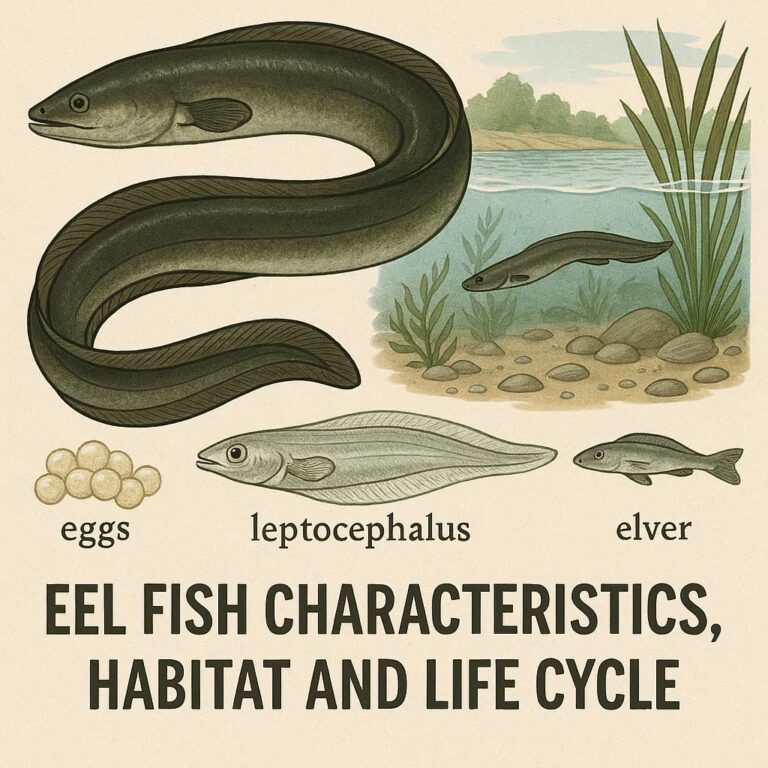
Eels are among the most mysterious animals on Earth, not only because of their strange life cycle but also because no one has ever witnessed their mating process in the wild. For over 2,000 years, scientists questioned how eels breed, where they mate, and what their offspring look like. Although we now have a clearer understanding of eel reproduction thanks to modern research, many parts of the process remain hidden beneath the deep waters of the Sargasso Sea.
This guide explores the entire known breeding process—from reproductive development to their mysterious spawning behaviors and the remarkable migration that sets the stage for mating. We will cover freshwater eels (Anguillidae) like the European and American eel, as well as how their mating differs from marine eels such as moray eels.
Why Eel Mating Has Been a Mystery for Thousands of Years
1. No one has ever seen eels mate
This remains true today.
Scientists have:
Never captured eels mating
Never filmed eel reproduction in the wild
Never found adult eels with eggs in freshwater rivers
Why?
2. Eels mate far out in the open ocean
Freshwater eels travel thousands of kilometers to the remote Sargasso Sea, a place extremely hard to study.
3. Adults die immediately after spawning
Dead adults sink before they are ever found.
4. Their larvae look nothing like eels
The first stage—leptocephalus larvae—are transparent, flat, leaf-like creatures previously mistaken for another species.
5. Eels have complex internal development
Freshwater eels only develop sexual organs at the very end of their lives, during migration. This adds to the confusion because eels caught in rivers have:
No mature gonads
No eggs
No sperm
Ancient scientists concluded they must be “genderless,” “born from mud,” or “spontaneously generated.”
The Journey to the Breeding Grounds
Before we understand mating, we must understand the transformation from yellow eel → silver eel.
Yellow Eel (Growth Stage)
Eels spend 5–30 years living in:
Rivers
Lakes
Coastal estuaries
They feed at night and grow slowly.
Silver Eel (Breeding Stage)
When ready to reproduce, they undergo metamorphosis:
Skin turns metallic silver
Belly becomes lighter
Eyes double in size
Digestive system shuts down
Gonads begin maturing
Angular head becomes streamlined
Muscles increase in density
Fat reserves grow
This transformation prepares them for a marathon migration thousands of kilometers long.
The Migration to the Sargasso Sea
Where is the Sargasso Sea?
Located in the North Atlantic
Surrounded by ocean currents
Filled with sargassum seaweed
One of the most isolated regions in the world
Freshwater eels (European and American) migrate:
4,000–6,000 km (European eels)
~2,000 km (American eels)
They do this without eating, relying only on stored fat.
Why the Sargasso Sea?
Scientists believe it offers:
Warm waters ideal for egg development
Predator protection in dense seaweed
Stable currents to carry larvae back toward continents
The Sargasso Sea is the only known spawning ground for both European and American eels.
How Do Eels Mate? (What Science Knows)
Although direct observation is lacking, decades of study allow scientists to construct the most likely scenario.
1. Males and females gather in deep, warm ocean layers
Tagging studies show they dive between:
200–800 meters regularly
Possibly deeper when near spawning time
These massive vertical migrations may be linked to:
Predation avoidance
Temperature signaling for reproduction
Navigation cues
2. Hormone changes trigger final sexual development
When eels reach the Sargasso Sea:
Female ovaries rapidly swell
Eggs mature and become buoyant
Males produce milt (sperm fluid)
Gonads reach their final reproductive stage
Females may carry millions of eggs.
3. Eels likely spawn in synchronized groups
Most marine fish that spawn in open ocean do so in:
Swarms
Coordinated clusters
Cloud-like release of eggs and sperm
Eels likely behave similarly.
4. External fertilization
Eels reproduce like most bony fish:
Females release clouds of eggs
Males release sperm into the water
Fertilization occurs externally
5. Adults die shortly after spawning
Once they disperse eggs and sperm:
Their bodies are depleted
Gonads remain empty
They sink into the deep ocean and die
This explains why no one finds post-spawning adults.
What Depth Do Eels Mate At?
Researchers believe eels spawn at around:
500–700 meters deep
Supported by:
Maturity of gonads at these depths
Temperature preference (16–18°C)
Tag data showing deep dives prior to arrival
They may ascend slightly when releasing eggs.
Timing: When Do Eels Actually Mate?
It varies by species but generally:
European Eels
Spawn between:
February and April
American Eels
Spawn closer to:
February–March
Peak spawning may occur just before sunrise when:
Light is low
Predation risk is minimized
How Many Times Do Eels Reproduce?
Only once.
Eels are semelparous, meaning:
They reproduce once
Then die
This is similar to salmon but far more mysterious due to the ocean depth and distance involved.
How Moray Eels and Other Marine Eels Mate (Different From Freshwater Eels)
Moray eels and other marine species have completely different mating habits from freshwater eels.
Moray Eel Mating Behavior
Occurs in coral reefs
Males and females may wrap bodies together
Eggs are externally fertilized
Adults survive after breeding
No long-distance migration
Larvae drift in the open ocean
Conger Eels
Similar to freshwater eels:
Migrate long distances
Die after spawning
Electric Eels (Not true eels)
These are knifefish—not eels—and:
Males build bubble nests
Females lay eggs in nests
Males guard the nest
This shows how “eel-like” shapes evolved multiple times independently.
The Eel Breeding Cycle (Complete)
1. Spawning
In the Sargasso Sea or ocean reefs.
2. Egg Stage
Tiny eggs drift with warm, nutrient-rich waters.
3. Leptocephalus Larvae
Flat, transparent larvae:
Float near the surface
Drift with the Gulf Stream
These larvae may drift:
1–3 years (European eels)
1 year (American eels)
4. Glass Eel Stage
Metamorphosis begins as they near land:
Transparent
Pigmentation begins
Enter rivers, estuaries, or coastal wetlands
Glass eels are highly valued in aquaculture.
5. Elvers
Glass eels develop colored skin and become stronger swimmers.
6. Yellow Eels
Spend decades feeding and growing inland.
7. Silver Eels
Transform for migration and breeding.
8. Return to Sargasso Sea
After decades of growth, they swim back to the ocean to reproduce and die.
How Scientists Study Eel Mating Without Ever Seeing It
Eels are extraordinarily difficult to study. Scientists rely on:
1. Satellite tagging
Tiny devices track:
Pressure (depth)
Temperature
Migration speed
Daily diving patterns
2. Genetics
Examining genetic diversity in larvae helps identify:
Mating strategies
Population mixing
3. Larvae surveys
Ships collect leptocephalus larvae in plankton nets to trace:
Their origin
Their migration timing
4. Artificial spawning in laboratories
Researchers can induce:
Gonad development
Egg release
Fertilization
However:
Larvae survive only weeks
Feeding is difficult
Replicating natural conditions is nearly impossible
This shows how unique and complex natural eel reproduction is.
Why Eel Mating Remains One of Biology’s Last Great Secrets
Even with all modern tools, we still lack:
Complete footage
Full behavior description
Direct observation of mating pairs
Confirmation of spawning depth
Knowledge of how they locate one another
The Sargasso Sea is:
Very deep
Vast
Difficult to access
Covered in thick mats of seaweed
Far from land
Subject to strong currents
This makes research extremely challenging.
Threats to Eel Reproduction and Long-Term Survival
Eels are in dramatic decline worldwide.
1. Overfishing of glass eels
Juveniles are captured by the millions for:
Food
Aquaculture
2. Dams blocking migration
Prevent yellow eels from reaching feeding grounds and silver eels from returning to the ocean.
3. Climate change
Alters crucial ocean currents that larvae depend on.
4. Habitat loss
River pollution and wetland destruction reduce yellow eel habitat.
5. Parasites
The swimbladder parasite Anguillicola crassus reduces migration success.
Conservation Efforts
Eel ladders help young eels bypass dams
Fishing bans protect glass eel populations
Habitat restoration improves rivers
International treaties regulate eel trade
Research continues into captive breeding
Still, eel species—especially European eels—remain critically endangered.
Conclusion: The Secret Life of Eels
Eels mate in a way unlike almost any other animal on Earth. Their breeding cycle involves:
A complete transformation of their bodies
One of the longest migrations of any fish
Spawning in a remote deep-ocean location
Larval forms so strange they were once misidentified
A life journey that ends in death immediately after reproduction
Even now, the mating of eels remains partly unsolved—one of the last great mysteries of modern marine biology. Researchers continue to search for answers, but the eel’s secret breeding grounds lie hidden deep beneath the Sargasso Sea’s blue water and floating seaweed.
One thing is clear: understanding eel reproduction is critical for saving these extraordinary creatures before they disappear.






